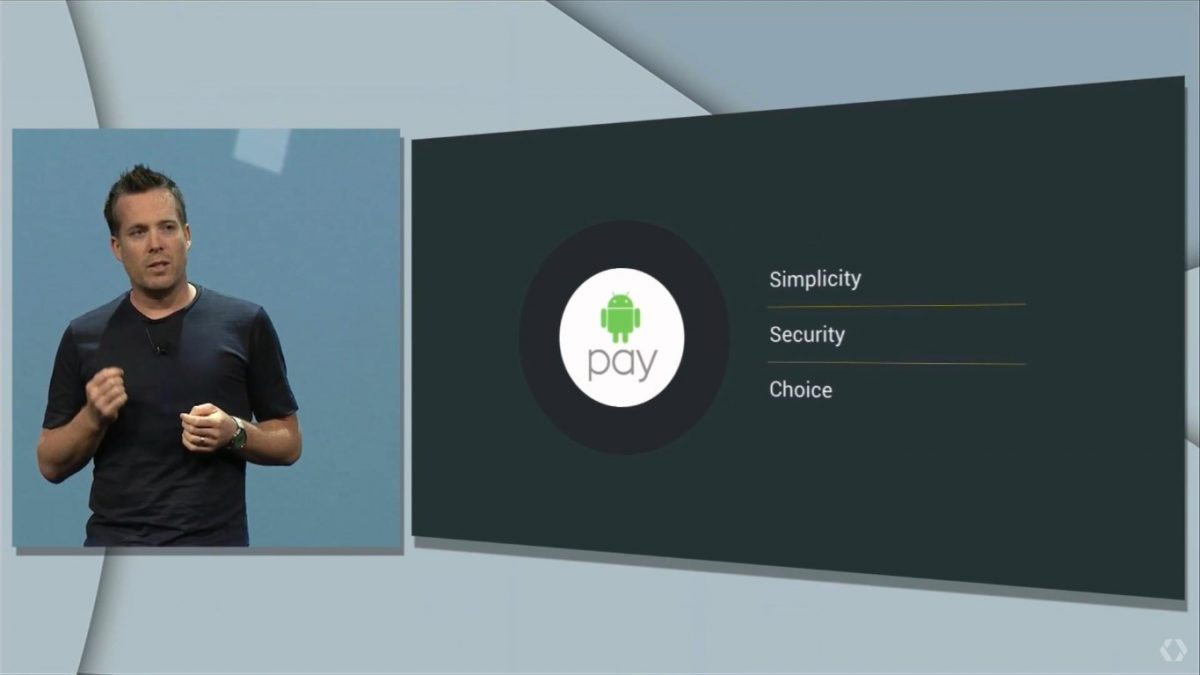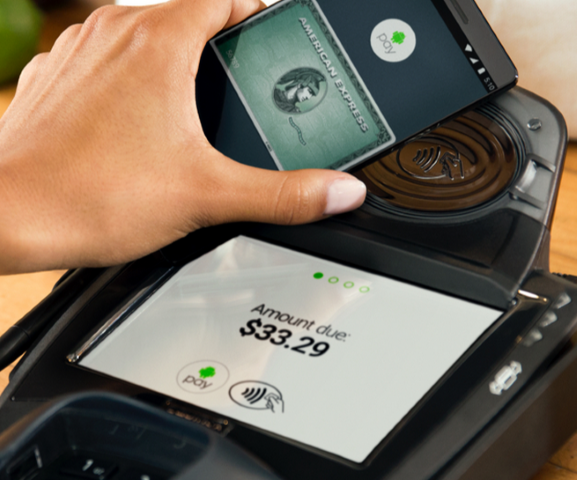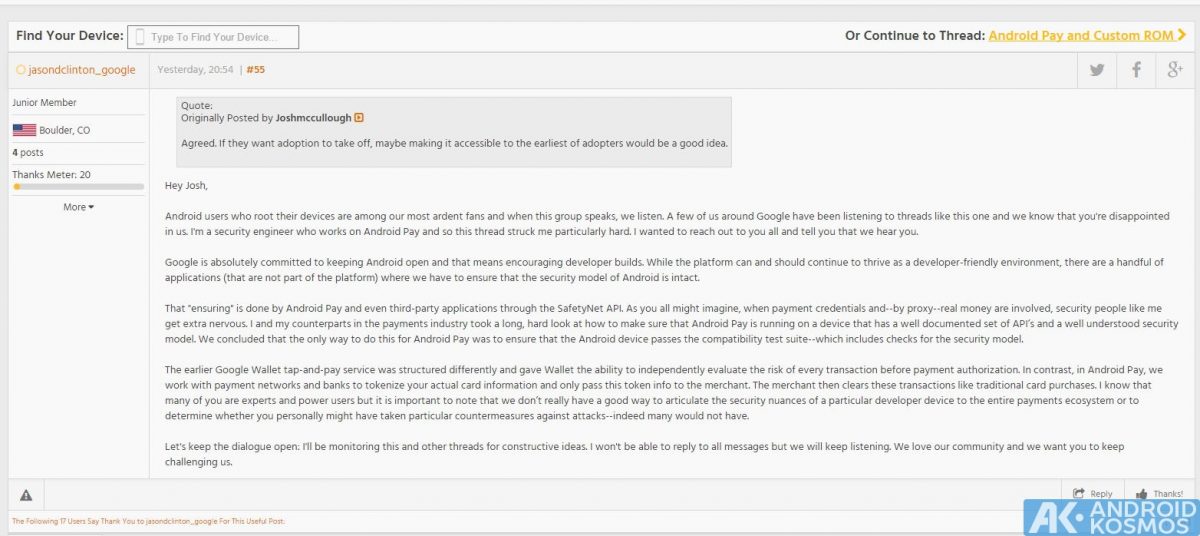Google Android Pay Bezahldienst gestartet und nur ohne Root nutzbar

Die meisten von euch werden wahrscheinlich von dem neuen Bezahldienst Android Pay von Google schon etwas gehört haben.
Dieser spezielle Dienst wurde zusammen mit Android M auf der diesjährigen Google I/O 2015 vorgestellt, welcher unter den drei Hauptpunkten Simpliciy (Einfachheit), Security (Sicherheit) und Choice (Auswahl) präsentiert wurde. Wir haben bereits darüber berichtet Google I/O 2015 Keynote: Android M 6.0 Preview – was uns erwartet
Android Pay im kurzen Überblick
Die Bezahlung erfolgt über den NFC-Chip, welcher in den meisten Smartphones eingebaut ist.Für die Bezahlung hält man dann sein Gerät einfach an das Zahl-Terminal. Beim Bezahlvorgang erhält der Nutzer anschließend eine kurze Transaktionsbestätigung direkt auf den Smartphone-Bildschirm und bestätigt die Zahlung darüber.
Diese Vorgehensweise ist allerdings in Deutschland noch nicht ganz so verbreitet. Aldi und Lidl (und einige mehr) ermöglichen es mittlerweile damit bargeldlos bezahlen zu können. Weitere werden aber wohl nach und nach folgen.

Bei Geräten mit Fingerabdrucksensor kann man diesen auch für Android Pay verwenden. Bevor also die Bezahlung per Pay vollzogen werden kann, muss dies vorher mit dem eigenen Fingerabdruck bestätigt werden. Dazu hält man den entsprechenden Finger einfach auf das Android Pay Symbol.
Android Pay Startschuss ab jetzt
Eigentlich sollte der Startschuss erst im Oktober diesen Jahres nach Vorstellung der neuen Nexus Geräte sein. Aber Google hat es anscheinend eilig damit und startet den neuen Bezahldienst ab sofort, leider aber erstmal nur in den USA. Wie wir bereits aus den letzten Nexus-Leaks wissen, kommt sowohl das Nexus 5X und Nexus 6P mit einem Fingerabdrucksensor. Der Hauptgrund dafür ist sicherlich auch Android Pay. Android Pay unterstützt die Kredit- und Debitkarten von American Express, Discover, MasterCard und Visa.
Wann man in hierzulande mit dem Bezahldienst Android Pay rechnen kann ist leider noch nicht bekannt.
Android Pay funktioniert nicht auf Geräten mit Rootrechte
In einem Forumbeitrag auf XDA-Developers.com hat jetzt ein Google-Mitarbeiter bekannt gegeben, dass Android Pay nicht auf Geräten mit Rootrechten funktionieren wird. Der Grunddafür ist simpel die Sicherheit. Google kann hier für Android Pay über die Safety/NET API nur eine vollständige Sicherheit garantieren, wenn die Smartphones nicht über Rootrechte verfügen. Das ist natürlich verständlich und nachvollziehbar.
Android users who root their devices are among our most ardent fans and when this group speaks, we listen. A few of us around Google have been listening to threads like this one and we know that you’re disappointed in us. I’m a security engineer who works on Android Pay and so this thread struck me particularly hard. I wanted to reach out to you all and tell you that we hear you.
Google is absolutely committed to keeping Android open and that means encouraging developer builds. While the platform can and should continue to thrive as a developer-friendly environment, there are a handful of applications (that are not part of the platform) where we have to ensure that the security model of Android is intact.
That “ensuring” is done by Android Pay and even third-party applications through the SafetyNet API. As you all might imagine, when payment credentials and–by proxy–real money are involved, security people like me get extra nervous. I and my counterparts in the payments industry took a long, hard look at how to make sure that Android Pay is running on a device that has a well documented set of API’s and a well understood security model. We concluded that the only way to do this for Android Pay was to ensure that the Android device passes the compatibility test suite–which includes checks for the security model.
The earlier Google Wallet tap-and-pay service was structured differently and gave Wallet the ability to independently evaluate the risk of every transaction before payment authorization. In contrast, in Android Pay, we work with payment networks and banks to tokenize your actual card information and only pass this token info to the merchant. The merchant then clears these transactions like traditional card purchases. I know that many of you are experts and power users but it is important to note that we don’t really have a good way to articulate the security nuances of a particular developer device to the entire payments ecosystem or to determine whether you personally might have taken particular countermeasures against attacks–indeed many would not have.
Let’s keep the dialogue open: I’ll be monitoring this and other threads for constructive ideas. I won’t be able to reply to all messages but we will keep listening. We love our community and we want you to keep challenging us.
Quelle: Android Pay | 2 | Google I/O 2015


